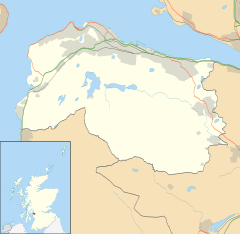Finnart facts for kids
Quick facts for kids Finnart |
|
|---|---|
| OS grid reference | NS253767 |
| Council area | |
| Lieutenancy area | |
| Country | Scotland |
| Sovereign state | United Kingdom |
| Post town | GREENOCK |
| Postcode district | PA19 |
| Dialling code | 01475 |
| Police | Strathclyde |
| Fire | Strathclyde |
| Ambulance | Scottish |
| EU Parliament | Scotland |
| UK Parliament |
|
| Scottish Parliament |
|
Finnart refers to an area of land located west of Greenock in Scotland. Long ago, in the Middle Ages, these lands were owned by a powerful noble called the Earl of Douglas. Around the year 1455, the king took these lands from the Earl of Douglas. This is called "forfeiting" the land.
After this, the Finnart lands were given to the Hamilton family. A western part of Finnart, known as the barony of Finnart-Stewart, went to another family, the Stewarts of Castlemilk. This area later became the town of Gourock.
Later, Sir James Hamilton of Finnart inherited the Finnart lands. He became a very important person in the Scottish government. However, he lost the king's favor and was executed in 1540. His lands were taken by the crown again. These lands then went to the Shaw family and eventually became the west end of Greenock.
Today, the northern part of the old Finnart-Stewart lands makes up most of modern Gourock. The rest of the area includes housing estates in the southwest of Greenock.
Contents
Where is Finnart Located?
The original Finnart lands, owned by the Douglas family, were west of the area known as Greenock. The border between them was a small stream called the "Hole or West-burn." This stream now flows underground beneath Greenock's town centre. It then goes into the River Clyde, which was the northern border of Finnart.
The southern border of Finnart was a valley that led to Inverkip. The West Burn flows through this valley, near where the A78 road is today. The area that was once Finnart now includes parts of Greenock West and the Bow Farm housing estate.
Old Boundaries and Modern Areas
The old border between Finnart and Gourock separated Easter Finnart from Finnart-Stewart. Finnart-Stewart stretched from a place called Achaneich to Achamead. Auchneagh House, an old building, was near Fancy Farm, just west of the old town border. Today, Auchneagh Road marks this spot, and it's now a housing estate in Greenock.
The farms of Aughmead and West Aughmead were about 1 mile (1.6 km) further west. They were located west of Aughmead Road. This area is now home to the Larkfield and Braeside housing estates in southwest Greenock. These estates are south of the current border with Gourock.
An old map from 1880 shows Gourock estate's borders, including Auchneagh, Aughmead, and Braeside. It even stretched as far as Loch Thom. The map also showed the western border as the Mile Burn. An old book from 1782 mentioned a "walk-mill" (a type of mill) called "Elie-mill" within the Gourock area. This mill was located near where Aileymill Gardens is today.
The History of Finnart Lands
The powerful Earl of Douglas owned many lands, including Finnart, which was west of Greenock. In 1455, King James II of Scotland took these lands from the Earl of Douglas because of disagreements. This meant the lands were "forfeited" to the crown.
In 1457, the king gave Finnart to the Hamilton family. The western part of Finnart was given to Sir Archibald Stewart of Castlemilk. This part later became known as the barony of Finnart-Stewart, with its main castle at Gourock castle.
Changes in Ownership
In 1510, James Hamilton, 1st Earl of Arran, passed the Finnart estate to his son, Sir James Hamilton of Finnart. He was also known as "The Bastard of Arran." Finnart became very powerful and was given many important jobs by King James V of Scotland.
However, in 1540, Finnart suddenly lost the king's trust and was executed. His lands were taken by the crown once more. King James V then gave the Finnart lands to Alexander Shaw of Sauchie and Greenock. Alexander Shaw passed them to his son, John Shaw, in 1542.
Later, in 1669, John Shaw's descendant bought more land, joining the Greenock areas. These combined lands were inherited by John Shaw Stewart in 1752. The lands are still owned by the Shaw Stewart baronets today.


